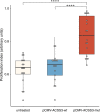Genomic and transcriptomic landscape of conjunctival melanoma
- PMID: 33383577
- PMCID: PMC7775126
- DOI: 10.1371/journal.pgen.1009201
Genomic and transcriptomic landscape of conjunctival melanoma
Abstract
Conjunctival melanoma (CJM) is a rare but potentially lethal and highly-recurrent cancer of the eye. Similar to cutaneous melanoma (CM), it originates from melanocytes. Unlike CM, however, CJM is relatively poorly characterized from a genomic point of view. To fill this knowledge gap and gain insight into the genomic nature of CJM, we performed whole-exome (WES) or whole-genome sequencing (WGS) of tumor-normal tissue pairs in 14 affected individuals, as well as RNA sequencing in a subset of 11 tumor tissues. Our results show that, similarly to CM, CJM is also characterized by a very high mutation load, composed of approximately 500 somatic mutations in exonic regions. This, as well as the presence of a UV light-induced mutational signature, are clear signs of the role of sunlight in CJM tumorigenesis. In addition, the genomic classification of CM proposed by TCGA seems to be well-applicable to CJM, with the presence of four typical subclasses defined on the basis of the most frequently mutated genes: BRAF, NF1, RAS, and triple wild-type. In line with these results, transcriptomic analyses revealed similarities with CM as well, namely the presence of a transcriptomic subtype enriched for immune genes and a subtype enriched for genes associated with keratins and epithelial functions. Finally, in seven tumors we detected somatic mutations in ACSS3, a possible new candidate oncogene. Transfected conjunctival melanoma cells overexpressing mutant ACSS3 showed higher proliferative activity, supporting the direct involvement of this gene in the tumorigenesis of CJM. Altogether, our results provide the first unbiased and complete genomic and transcriptomic classification of CJM.
Conflict of interest statement
The authors have declared that no competing interests exist.
Figures






References
-
- WHO classification of tumors of the eye. In: Paperpile [Internet]. [cited 9 Sep 2019]. Available from: https://paperpile.com/shared/WH2l3x.
-
- Tuomaala S, Eskelin S, Tarkkanen A, Kivelä T. Population-based assessment of clinical characteristics predicting outcome of conjunctival melanoma in whites. Invest Ophthalmol Vis Sci. 2002;43:3399–3408. - PubMed
Publication types
MeSH terms
Substances
LinkOut - more resources
Full Text Sources
Medical
Research Materials
Miscellaneous

